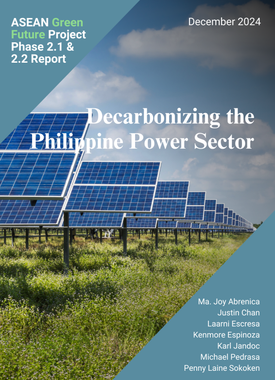
Decarbonizing the Philippine Power Sector (Phase 2.1 & 2.2 Report)
The Philippines report presents its results for Phase 2 of the ASEAN Green Future (AGF), modeling pathways for a low-carbon transition in a fully market-based electricity system. Using the Stockholm Environment Institute’s Low Emission Analysis Platform (LEAP), the analysis assesses least-cost capacity expansion and dispatch to meet projected demand while aligning with government policies and targets. Scenarios include the Existing Policies Pathway (EPP), based on current policies, programs, and targets, which stabilizes greenhouse gas (GHG) emissions but does not reduce them below current levels; several More Ambitious Pathway (MAP) variants, which accelerate renewable energy (RE) deployment and emission reductions through stronger policy measures; and cost-effective Optimized Existing Policies Pathway (OEPP) and Optimized More Ambitious Pathway (OMAP) scenarios. OEPP improves reliability and cost efficiency within existing policy constraints, while OMAP decommissions all fossil-fueled plants, replaces them with RE, and upgrades the grid to manage RE intermittency. Results show that EPP maintains emissions at current levels, MAP variants bring the system closer to net zero but face cost and social acceptability concerns, OEPP enhances efficiency but retains fossil reliance, and OMAP achieves the deepest decarbonization while requiring significant investment and addressing legal and public perception challenges. The report underscores the need to balance emissions reduction, energy affordability, investment requirements, and social acceptability in the Philippine power sector’s decarbonization journey.
Downloads and Related Links